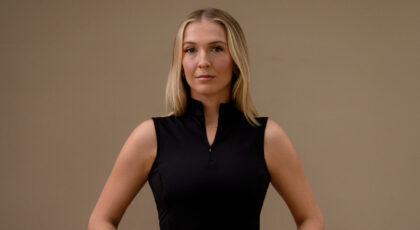“It’s something meaningful I can do to improve a few lives.” — Sigrid Haines on adopting nine horses from Days End Farm Horse Rescue
–As told to Alice Collins / Jump Media
I was like every horse-loving little girl. I had lots of plastic ponies and was constantly begging for a horse. I took lessons, but when my instructor said it was time to get my own horse, my parents balked at the financial and time commitment and steered me toward other hobbies.
Now, I’m making up for lost time. I have adopted nine horses from Days End Farm Horse Rescue (DEFHR) in Woodbine, MD, and I have been a member of the board of directors on and off since its inception in 1989. Yes, there are some serious questions about my sanity. But some people have kids while others have expensive taste in clothing… I just like horses.
It all started when I was in my mid-50s. I was already interested in horses and I was volunteering — local jump-judging, stuff like that — when I saw Harpo in a newsletter featuring horses looking for homes called “The Horse”, which DEFHR had signed me up to receive. He was a black pony with white spots who was retired from a therapeutic riding club near my home in Maryland. I thought, ‘How much trouble can a pony really be?’
I went to see him and fell head over heels. I agreed to adopt him, even though I didn’t have anywhere to keep him or the first clue about how to properly care for him. I sat in the riding center’s parking lot Googling boarding facilities.
While a lot of places had higher aspirations, with FEI dressage trainers and the like, I just wanted a nice life for a retired pony. I found a barn 20 minutes from my house clearly aimed at people like me and naively thought my dreams were coming true.
Two weeks later, Harpo arrived, and he hated me, he hated the barn — he hated everything! It was a shock to the system. I finally had the horse I’d always wanted, and it wasn’t anything like I imagined!
I found a trainer to help me with this unhappy situation, and within two weeks, everything turned around. The first lesson she gave me was just how to give Harpo a bath. Then I learned how to pick his hooves, and he slowly decided I was OK, and eventually, we became best buds.

I sent regular updates to the therapeutic riding center’s team about how he was doing. Soon enough, they told me about another horse they had up for adoption, named May. There happened to be an open stall at my barn, so I adopted her, and the two of them lived happily together for three years.
I even rode May a few times. But, I fell off her twice and thought, ‘What am I doing? I don’t even like riding!’ And that was the end of that.
Harpo thrived on learning tricks. He could do things like walk backward over poles, unroll a carpet, and pick up brushes on command. When, at age 27, his degenerating shoulder joints got the best of him, I was devastated.
May did not want to take on the tricks mantle — she did not want to play or work and mostly enjoyed posing for the camera. I was only permitted to admire her. I really missed that interaction with a horse. I called DEFHR and asked if they had any horses available that wanted to play. I went to see two candidates, and since I couldn’t decide, I adopted them both.
It seems that every time I lose a horse, I gain two more, which is how the numbers got so crazy.
Nicki the Shetland and Santana the black pony joined my crew. Santana, who might have been a retired Amish cart horse, enjoyed learning tricks, but sadly succumbed to laminitis. Nicky, however, is still with me. She can count, roll a ball, and even predict presidential elections with a shake of her head.
I just kept on adopting more: Mocha, Gypsy from the DEFHR Guardian Program, Zaylee, Colton, Peter, Uli and Tiki. I also adopted Pumpkin (because she’s round, orange, and came in October) through DEFHR’s Owner-2-Owner program. It’s quite a long list.
I know it sounds silly, but adopting all these horses is something meaningful I can do to improve a few lives. I was extremely frugal when I was young. My dad was a businessman, and I was an accounting major, which is how I’m able to do this now.

I’m not saving for kids or college, and some of the horses come with tax breaks. The DEFHR team is truly amazing. They do an awful lot of work educating owners about good horse care, often resulting in improved conditions and lives for the horses in question.
When things go beyond that and horses are confiscated — it’s not DEFHR making the confiscation decisions — they take in horses, assess their needs, and do an incredible job restoring each horse’s physical condition. Then, they teach them useful life skills to give them a better chance of being adopted.
They’re so skilled in figuring out how to make each animal thrive, which is remarkable given that they have about 80 horses at the farm at any given time. Their deep understanding of each horse means they are perfectly set up to find the right place for each one to land.
I’m 66 now, and I feel peace and calm when I take care of these horses. They love me unconditionally (when I have treats), and I always drive away from the barn feeling better than when I arrive. I get exercise, and I’ve made lots of friends. I believe few things are more satisfying than caring for an animal that needs care. It’s hugely rewarding.
If you are looking to offer a horse in need a home or support DEFHR’s live-saving work, please visit their website.


 February 26, 2025
February 26, 2025 


























